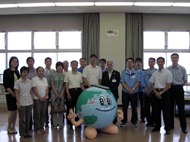Events
Workshop on the advanced sewage technology between Japan and China for water environment
Date: July 23 - 24 and 27, 2009
Venue: Tokyo Metropolitan Government, NILIM, Water Reclamation Center of Tokyo pref., Mobara city of Chiba pref., Lake Kasumigaura
Organized by:
- Kyoto University Global COE Program "Global Center for Education and Research on Human Security Engineering for Asian Megacities"
- SCF Project "International Center for Human Resources Development in Environmental Management"
Number of attendants: 9
Report 050
Outline
Department of environmental science and engineering, Tsinghua University has been conducting the 11th five-year project in Changzhou city. This project aims to develop novel treatment technology, elaborate a reforming plan of sewage, and conduct direct cleaning for the lake and the river, in order to prevent further pollution of Lake Tai in Changzhou. The aims of the workshops were the following: to introduce Japanese advanced sewage systems and management method of sewerage pipes to participants from China, and to have them reflect their findings from site visits in the five-year project. The participants of the workshops were faculties of Tsinghua University, which leads the project, and engineers of Changzhou, which manages and operates treatment facilities in Changzhou. It was therefore expected that relationship between Japan and China constructed in the Shenzhen base would strengthen further.
Report
Workshops were held in the Metropolitan Government Office on July 23, and in National Institute for Land and Infrastructure Management Ministry of Land, Infrastructure, Transport and Tourism (NILIM) on July 27. Responding to the Chinese participants' request, detection method for miss-connection of sewer pipes in separate sewer system and CSO control technology were introduced at the Tokyo Metropolitan Government. At NILM, the participants received comprehensive explanation of Japanese sewer technologies, for example, asset management technology that commanded attention in recent years, prevention of corrosion of vacuum sewer system, sump pits, and water quality conservation in non- sewered area. Similar technologies had been already employed in Changzhou. The participants had active discussion on the advantage of Japanese technology and differences between the two countries.
We visited a wastewater treatment plant with CSO control in Tokyo, a vacuum sewer system in Chiba, and water treatment facilities of Lake Kasumigaura. The wastewater treatment plant with a high-rate filtration process was introduced as an example of CSO control technology, and the participants were particularly interested in filter media. At the vacuum sewer system, we had a discussion on a problem of occlusion of pipes, and its detection method. The participants received the explanation of water quality control by natural process used for Lake Kasumigaura, such as nutrients removal by floating islands, protection of reed beds, and water purification by plant growing from dredged soil. Lake Tai is one of the most polluted lakes in China. The participants from Changzhou were strongly interested in such technology, and they eagerly asked its effects.
The Chinese participants were versed in Japanese advanced technologies regarding water quality control. Also we engaged in valuable information exchanges. We aim at building an even better relationship between the two countries through the participants of the seminar.


